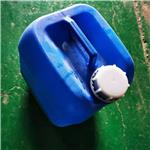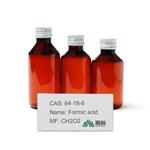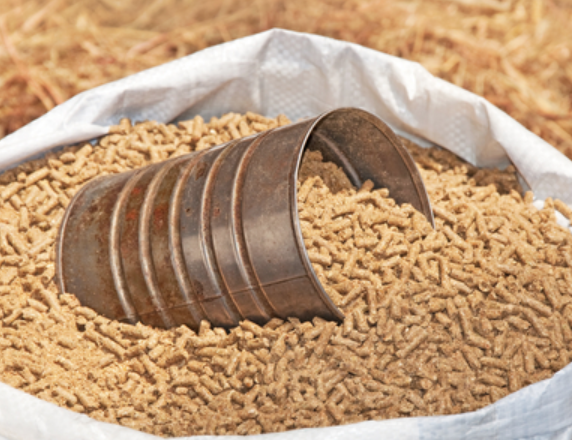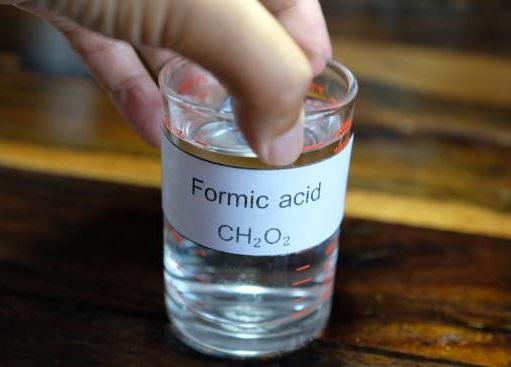Formic Acid
Formic Acid
Contents
1 Introduction
2 Properties
3 Natural occurrence
4 Production
4.1 From methyl formate and formamide
4.2 By- product of acetic acid production
4.3 Hydrogenation of carbon dioxide
4.4 Laboratory methods
5 Uses
5.1 Laboratory use
6 Reactions
6.1 Decomposition
6.2 Addition to alkenes
6.3 Formic acid anhydride
7 History
8 Safety
1 - Introduction
Formic acid (also called methanoic acid) is the simplest carboxylic acid. Its chemical formula is HCOOH or HCO2H. It is an important intermediate in chemical synthesis and occurs naturally, most notably in the venom of bee and ant stings. In fact, its name comes from the Latin word for ant, formica, referring to its early isolation by the distillation of ant bodies. Esters, salts, and the anion derived from formic acid are referred to as formates.
IUPAC name : Formic acid
Systematic name : Methanoic Acid
Other names :
Aminic acid ;
Formylic acid ;
Hydrogen carboxylic acid ; Hydroxymethanone;
Hydroxy(oxo) methan ;
Meta carbonoic acid ;
Oxocarbinic acid ; Oxo methanol
Molecular formula CH2O2
Molar mass 46 g mol−1
Appearance Colorless iquid
Density 1.22 g / mL
Melting point 8.4 °C
Boiling point 100.8 °C
Solubility in water Miscible
Acidity (pKa) 3.77
Viscosity 1.57 cP at 26 °C
Main hazards Corrosive ; irritant ; sensitizer.
Flash point 69 °C
Auto ignition temperature 601 °C
Structure and properties n , εr , etc.
Thermo dynamic data Phase behaviour
Solid , liquid , gas
Spectral data UV, IR , NMR , MS
2 - Properties
Formic acid is a colorless liquid having a highly pungent, penetrating odor at room temperature. It is miscible with water and most polar organic solvents, and is somewhat soluble in hydrocarbons. In hydrocarbons and in the vapor phase, it consists of hydrogen-bonded dimers rather than individual molecules . Owing to its tendency to hydrogen - bond, gaseous formic acid does not obey the ideal gas law. Solid formic acid (two polymorphs) consists of an effectively endless network of hydrogen - bonded formic acid molecules. This relatively complicated compound also forms a lowboiling azeotrope with water ( 22.4 % ) and liquid formic acid also tends to supercool.
3 - Natural occurrence
In nature, it is found in the stings and bites of many insects of the order Hymenoptera, mainly ants. Formic acid is a naturally occurring component of the atmosphere due primarily to forest emissions.
4 - Production
In 2009, the world wide capacity for producing this compound was 720,000 tones / annum, with production capacity roughly equally divided between Europe (350,000, mainly in Germany) and Asia (370,000, mainly in China), while production was below 1000 tonnes/annum in all other continents. It is commercially available in solutions of various concentrations between 85 and 99 w/w %.[4] As of 2009[update], the largest producers are BASF, Kemira and Feicheng Acid Chemicals, with the largest production facilities in Ludwigshafen (200,000 tones / annum, BASF, Germany), Oulu (105,000, Kemira, Finland) and Feicheng (100,000, Feicheng, China). 2010 Prices ranged from circa € 650 / tonne in Western Europe and $ 1250/tonne in the United States.
4 – 1 - From methyl formate and formamide
When methanol and carbon monoxide are combined in the presence of a strong base, the acid derivative methyl formate results, according to the chemical equation:
CH3OH + CO → HCO2CH3
In industry, this reaction is performed in the liquid phase at elevated pressure. Typical reaction conditions are 80 °C and 40 atm.
The most widely-used base is sodium methoxide. Hydrolysis of the methyl formate produces formic acid:
HCO2CH3 + H2O → HCO2H + CH3OH
Efficient hydrolysis of methyl formate requires a large excess of water. Some routes proceed indirectly by first treating the methyl formate with ammonia to give formamide, which is then hydrolyzed with sulfuric acid:
HCO2CH3 + NH3 → HC(O)NH2 + CH3OH
2 HC(O)NH2 + 2 H2O + H2SO4 → 2HCO2H + (NH4)2SO4
This approach suffers from the need to dispose of the ammonium sulfate byproduct. This problem has led some manufacturers to develop energy efficient means for separating formic acid from the large excess amount of water used in direct hydrolysis. In one of these processes (used by BASF) the formic acid is removed from the water via liquid-liquid extraction with an organic base.
4 – 2 - By - product of acetic acid production
A significant amount of formic acid is produced as a by product in the manufacture of other chemicals. At one time, acetic acid was produced on a large scale by oxidation of alkanes, via a process that cogenerates significant formic acid. This oxidative route to acetic acid is declining in importance, so that the aforementioned dedicated routes to formic acid have become more important.
4 – 3 - Hydrogenation of carbon dioxide
The catalytic hydrogenation of CO2 has long been studied. This reaction can be conducted homogeneously.
4 – 4 - Laboratory methods
In the laboratory, formic acid can be obtained by heating oxalic acid in glycerol and extraction by steam distillation. Glycerol acts as a catalyst, as the reaction proceeds through a glyceryl oxalate intermediary. If the reaction mixture is heated to higher temperatures, allyl alcohol results. The net reaction is thus:
C2O4H2 → CO2H2 + CO2
Another preparation (which must be performed under a fume hood) is the acid hydrolysis of ethyl isonitrile (C2H5NC) using HCl solution.
C2H5NC + 2 H2O → C2H5NH2 + HCO2H
The isonitrile can be obtained by reacting ethyl amine with chloroform (note that the fume hood is required because of the overpoweringly objectionable odor of the isonitrile).
5 - Uses
A major use of formic acid is as a preservative and antibacterial agent in livestock feed. In Europe, it is applied on silage (including fresh hay) to promote the fermentation of lactic acid and to suppress the formation of butyric acid; it also allows fermentation to occur quickly, and at a lower temperature, reducing the loss of nutritional value. Formic acid arrests certain decay processes and causes the feed to retain its nutritive value longer, and so it is widely used to preserve winter feed for cattle. In the poultry industry, it is sometimes added to feed to kill E. coli bacteria . Use as preservative for silage and (other) animal feed constituted 30 % of the global consumption in 2009.
Formic acid is also significantly used in the production of leather, including tanning (23 % of the global consumption in 2009[7]), and in dyeing and finishing of textile (9 % of the global consumption in 2009 ) because of its acidic nature. Use as a coagulant in the production of rubber constituted in 2009 6 % of the global consumption.
Formic acid is also used in place of mineral acids for various cleaning products, such as limescale remover and toilet bowl cleaner. Some formate esters are artificial flavorings or perfumes. Beekeepers use formic acid as a miticide against the tracheal mite (Acarapis woodi) and the Varroa mite. The use of formic acid in fuel cells is also under investigation.
5 – 1 - Laboratory use
Formic acid is a source for a formyl group for example in the formylation of methylaniline to N-methylformanilide in toluene. In synthetic organic chemistry, formic acid is often used as a source of hydride ion. The Eschweiler-Clarke reaction and the Leuckart- Wallach reaction are examples of this application. It, or more commonly its azeotrope with triethylamine, is also used as a source of hydrogen in transfer hydrogenation.
Like acetic acid and trifluoroacetic acid, formic acid is commonly used as a volatile pH modifier in HPLC and capillary electrophoresis.
As mentioned below, formic acid may serve as a convenient source of carbon monoxide by being readily decomposed by sulfuric acid.
6 - Reactions
Formic acid shares most of the chemical properties of other carboxylic acids. Reflecting its high acidity, its solutions in alcohols form esters spontaneously. Formic acid shares some of the reducing properties of aldehydes, reducing solutions of gold, silver, and platinum to the metals.
6 – 1 - Decomposition
Heat and especially acids cause formic acid to decompose to carbon monoxide (CO) and water (dehydration). Treatment of formic acid with sulfuric acid is a convenient laboratory source of CO. In the presence of platinum, it decomposes with a release of hydrogen and carbon dioxide. Soluble ruthenium catalysts are also effective . Carbon monoxide free hydrogen has been generated in a very wide pressure range (1- 600 bar). Formic acid has even been considered as a material for hydrogen storage. The co - product of this decomposition, carbon dioxide, can be rehydrogenated back to formic acid in a second step. Formic acid contains 53 g L−1 hydrogen at room temperature and atmospheric pressure, which is three and a half times as much as compressed hydrogen gas can attain at 350 bar pressure (14.7 g L−1). Pure formic acid is a liquid with a flash point of + 69 °C, much higher than that of gasoline (– 40 °C) or ethanol (+ 13 °C).
6 – 2 - Addition to alkenes
Formic acid is unique among the carboxylic acids in its ability to participate in addition reactions with alkenes. Formic acids and alkenes readily react to form formate esters. In the presence of certain acids, including sulfuric and hydrofluoric acids, however, a variant of the Koch reaction occurs instead, and formic acid adds to the alkene to produce a larger carboxylic acid.
6 – 3 - Formic acid anhydride
An unstable formic anhydride, H ( C= O ) – O - ( C= O ) H, can be obtained by dehydration of formic acid with N,N'-Dicyclo hexyl carbo diimide in ether at low temperature.
7 - History
Some alchemists and naturalists were aware that ant hills give off an acidic vapor as early as the 15th century. The first person to describe the isolation of this substance (by the distillation of large numbers of ants) was the English naturalist John Ray, in 1671. Ants secrete the formic acid for attack and defense purposes. Formic acid was first synthesized from hydrocyanic acid by the French chemist Joseph Gay-Lussac. In 1855, another French chemist, Marcellin Berthelot, developed a synthesis from carbon monoxide that is similar to that used today.
Formic acid was long considered a chemical compound of only minor interest in the chemical industry. In the late 1960s, however, significant quantities of it became available as a byproduct of acetic acid production. It now finds increasing use as a preservative and antibacterial in livestock feed.
8 - Safety
Formic acid has low toxicity (hence its use as a food additive), with an LD50 of 1.8 g / kg ( oral, mice ). The concentrated acid is, however, corrosive to the skin.
Formic acid is readily metabolized and eliminated by the body. Nonetheless, it has specific toxic effects; the formic acid and formaldehyde produced as metabolites of methanol are responsible for the optic nerve damage, causing blindness seen in methanol poisoning. Some chronic effects of formic acid exposure have been documented. Some experiments on bacterial species have demonstrated it to be a mutagen. Chronic exposure to humans may cause kidney damage. Another effect of chronic exposure is development of a skin allergy that manifests upon re-exposure to the chemical.
Concentrated formic acid slowly decomposes to carbon monoxide and water, leading to pressure buildup in the container it is kept in. For this reason, 98 % formic acid is shipped in plastic bottles with self-venting caps.
The hazards of solutions of formic acid depend on the concentration. The following table lists the EU classification of formic acid solutions:
Concentration (weight percent) Classification
2 % – 10 % Irritant (Xi)
10 % – 90 % Corrosive (C)
> 90 % Corrosive (C)
An assay for formic acid in body fluids, designed for determination of formate after methanol poisoning, is based on the reaction of formate with bacterial formate dehydrogenase.
Formic acid in 85 % concentration is not flammable, and diluted formic acid is on the US Food and Drug Administration list of food additives . The principal danger from formic acid is from skin or eye contact with the concentrated liquid or vapors. The US OSHA Permissible Exposure Level (PEL) of formic acid vapor in the work environment is 5 parts per million parts of air (ppm).
You may like
Related articles And Qustion
See also
Lastest Price from Formic acid manufacturers

US $0.00/KG2025-04-21
- CAS:
- 64-18-6
- Min. Order:
- 1KG
- Purity:
- 99%
- Supply Ability:
- 10 mt

US $10.00-500.00/kg2025-04-17
- CAS:
- 64-18-6
- Min. Order:
- 1000kg
- Purity:
- 0.98
- Supply Ability:
- 3000MT per year


